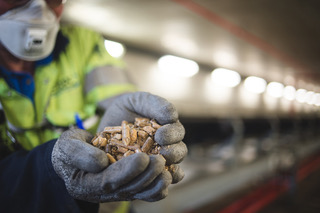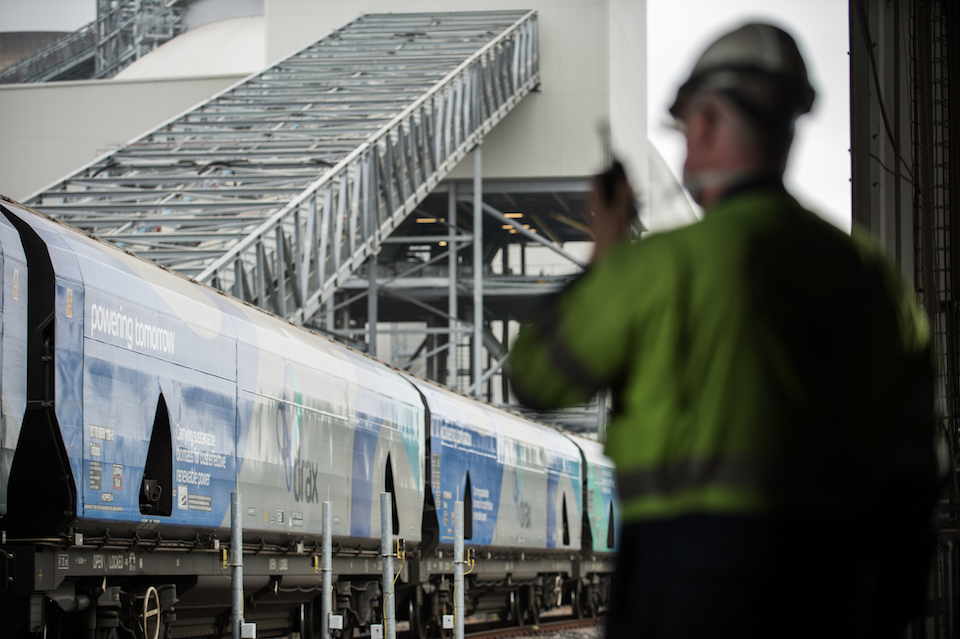The UK biomass wagon: a feat of engineering

Not coal, but wood pellets fuel up Drax, the power station that helps keep the lights on all over the UK. The high-tech wood pellets require an equally high-tech solution to get them to the furnaces. And this brings forth the most cavernous rail freight wagons on the network.
A handful may look like the sort of thing your cat would use to do her business, but it takes Britain’s biggest freight movers to bring it in by the thousands of tonnes. “The wagons used by Drax to transport biomass pellets are a feat of engineering in themselves”, says Mark Gibbens, head of logistics at Drax, the eponymous company that generates power from a variety of resources, from hydro in the Scottish glens, to huge industrial sites like this in North Yorkshire.

Evolving
Built as a coal-fired power station in the 1970s, Drax has been evolving over the decades. The procession of trains delivering bulk fuel to the huge complex may look similar, but they are as different from their twentieth-century coal-carrying counterparts as the cargo they deliver. “Biomass wood pellets have to be transported differently,” says Gibbens, as the weather proof fuel store domes tower above.
“Coal is a durable fuel that can be left open to the elements, whereas compressed wood pellets become unusable if they are exposed to moisture. Traditional hoppers, the large open-top wagons used to transport coal, are not big enough, nor do they provide the weather protection that biomass needs”.
Biggest wagons
The bespoke rolling stock was built in the UK by commercial partners Ricardo Rail and WH Davis. Extensively modified from open coal hoppers, each wagon has a pneumatically operated roof, extended load space, and unloading hoppers. Not only are they the first bespoke biomass wagons in the UK, they are also the largest volume wagons on the network. “We utilised unused space at the ends of traditional wagons to house the braking and control equipment cubicle and cleverly located pipework to create more storage space”, points out Gibbens.
When trains arrive at the power station, the wagons are discharged in an automated system. This releases pellets into a hopper that delivers them into storage, ready to be used for generation. “Each train can unload in under 40 minutes and the biomass pellets remain untouched by the elements”, says Gibbens. “We can tip up to 130 trains per week so it has to be an efficient operation”.

Busy schedule
Drax uses around 7.5 million tonnes of biomass a year. Most of that comes from suppliers in North America and Europe, and is shipped in. Drax bound biomass trains operate around 17 times a day, six days a week, from northern ports at Newcastle (Tyne), Hull, and Immingham, and on the West Coast at Liverpool.
According to the company, each train hauls enough fuel pellets to provide 815 houses in the UK with electricity for a year. Drax says that eliminates over a quarter of a million road truck journeys annually, and saves almost 33 kilo-tonnes of CO2.
Huge undertaking
“When we converted the power station from coal to biomass, it was a huge undertaking”, says Gibbens. “Not just the engineering skill and expertise required to transform the power station. We also had to develop a supply chain able to deliver the quantities of biomass we need”.
That explains the 50-metre tall storage domes, that hold enough fuel for northern England’s major cities for about a fortnight. That is about 300,000 tonnes on site, and another train-load on the way every hour and a half. Despite the temptation, cat-loving staff at Drax observe strict security and, if kitty is in need, they stop off at the pet store on the way home. Those pellets have been counted.
You just read one of our premium articles free of charge
Want full access? Take advantage of our exclusive offer





